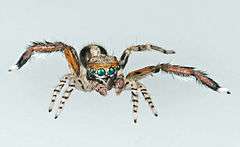Saitis
Saitis is a genus of jumping spiders that was first described by Eugène Louis Simon in 1876.[2] The Australian species may belong to other genera, such as Maratus.
| Saitis | |
|---|---|
 | |
| Saitis barbipes (male) | |
| Scientific classification | |
| Kingdom: | Animalia |
| Phylum: | Arthropoda |
| Subphylum: | Chelicerata |
| Class: | Arachnida |
| Order: | Araneae |
| Infraorder: | Araneomorphae |
| Family: | Salticidae |
| Genus: | Saitis Simon, 1876[1] |
| Type species | |
| S. barbipes (Simon, 1868) | |
| Species | |
|
32, see text | |
Species
As of August 2019 it contains thirty-two species, found worldwide:[1]
- Saitis annae Cockerell, 1894 – Jamaica
- Saitis aranukanus Roewer, 1944 – Kiribati (Gilbert Is.)
- Saitis ariadneae Logunov, 2001 – Greece (Crete)
- Saitis auberti Berland, 1938 – Vanuatu
- Saitis barbipes (Simon, 1868) (type) – Northern Africa, southern Europe to Turkey
- Saitis berlandi Roewer, 1951 – Vanuatu
- Saitis breviusculus Simon, 1901 – Gabon
- Saitis catulus Simon, 1901 – Venezuela
- Saitis chaperi Simon, 1885 – India, Sri Lanka
- Saitis cupidon (Simon, 1885) – New Caledonia
- Saitis cyanipes Simon, 1901 – Brazil
- Saitis graecus Kulczyński, 1905 – Albania, Greece, Bulgaria
- Saitis imitatus (Simon, 1868) – Croatia, Montenegro
- Saitis insectus (Hogg, 1896) – Central Australia
- Saitis insulanus Rainbow, 1920 – Australia (Lord Howe Is.)
- Saitis kandyensis Kim, Ye & Oh, 2013 – Sri Lanka
- Saitis lacustris Hickman, 1944 – Central Australia
- Saitis latifrons Caporiacco, 1928 – Libya
- Saitis magniceps (Keyserling, 1882) – Australia (Queensland)
- Saitis marcusi Soares & Camargo, 1948 – Brazil
- Saitis mutans Otto & Hill, 2012 – Australia (New South Wales)
- Saitis nanus Soares & Camargo, 1948 – Brazil
- Saitis perplexides (Strand, 1908) – Jamaica
- Saitis relucens (Thorell, 1877) – Indonesia (Sulawesi)
- Saitis sengleti (Metzner, 1999) – Greece (incl. Crete)
- Saitis signatus (Keyserling, 1883) – Unknown
- Saitis spinosus (Mello-Leitão, 1945) – Argentina
- Saitis splendidus (Walckenaer, 1837) – Timor
- Saitis taeniatus Keyserling, 1883 – Australia
- Saitis tauricus Kulczyński, 1905 – Italy, Hungary, Macedonia, Bulgaria, Greece, Turkey, Ukraine
- Saitis variegatus Mello-Leitão, 1941 – Argentina
- Saitis virgatus Otto & Hill, 2012 – Australia (New South Wales)
gollark: You would still get a massive backlog if you didn't read it at the same speed it was sent, but you could use the linked cards to send it directly/only to the one computer which needs it really fast.
gollark: You would still have to spam and read messages very fast, but it wouldn't affect anything else.
gollark: There are linked cards, which are paired card things which can just directly send/receive messages to each other over any distance. If the problem here is that your data has to run across some central network/dispatcher/whatever, then you could use linked cards in the thing gathering data and the thing needing it urgently to send messages between them very fast without using that.
gollark: It would be kind of inelegant and expensive, but maybe for time- and safety-critical stuff like this you could just send the data directly between the computers which need it by linked card.
gollark: You can save cell cost by allocating item types to cells such that you fill up your cells to max "bytes" rather than max "types".
References
- "Gen. Saitis Simon, 1876". World Spider Catalog Version 20.0. Natural History Museum Bern. 2019. doi:10.24436/2. Retrieved 2019-09-23.
- Simon, E. (1876). Les arachnides de France. Tome troisième. Roret, Paris.
External links
Further reading
- Hill, David Edwin (2009). "Euophryine jumping spiders that extend their third legs during courtship (Araneaee: Salticidia: Euophryinae: Maratus, Saitis)". Peckhamia. 74 (1): 1–27.
This article is issued from Wikipedia. The text is licensed under Creative Commons - Attribution - Sharealike. Additional terms may apply for the media files.